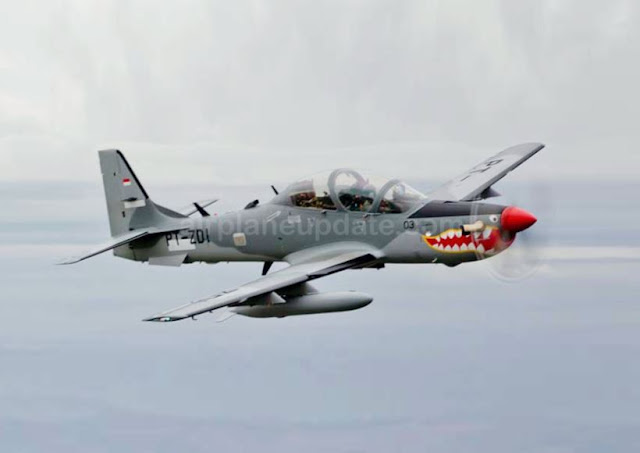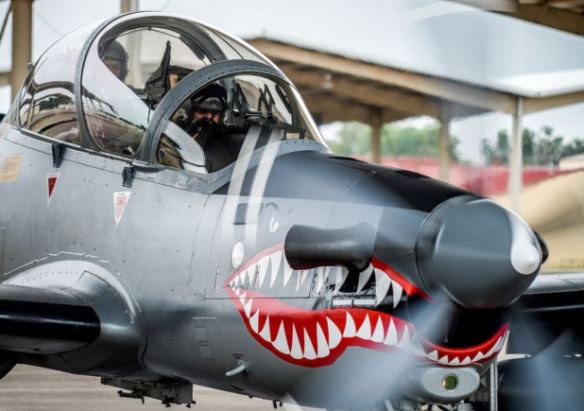Embraer EMB-314 Super Tucano Specs, Engine, Cockpit, and Price – EMB-314 Super Tucano is a turboprop-engined light combat aircraft manufactured by Embraer Defense System, Brazil. EMB-314 Super Tucano is an enhanced version of the EMB-312 Tucano training aircraft, improvements made from previous aircraft including avionics systems, weapons systems and data communication systems. The Super Tucano prototype first flew in 1992.
EMB-312 Tucano is a military aircraft with low operational costs, around USD 1,000 per hour flight. Minimum infrastructure and ground support are needed, rapid error identification and ease of correction & intensive use of the maintenance concept of on-condition.
This aircraft is suitable for basic and advanced pilot training. The aircraft's main mission is border patrol and counter-insurgency operations. In addition, the right air to ground attack mode is combined with various weapon configurations to succeed in dynamic battle scenarios.

The EMB-314 Super Tucano is equipped with a fully integrated EO / IR system, exceptional visibility of seats and night operations with full capabilities with Night Vision Goggles (NVG). So it is very suitable for border patrols and armed reconnaissance. With incredible speed, altitude and range, it is highly maneuverable for aircraft tapping, exceptional visibility from both cockpits, and capable of operating day / night.
The EMB-314 Super Tucano is equipped with a complete system set for: Reconnaissance and appointment of targets. Supports the acquisition and attack of real-time targets.

Its fuel capacity is 695l, which provides a range of more than 1,500 km and endurance of 6 hours 30 minutes. EMB-314 can fly at 24m / s. The maximum speed and cruising of each aircraft are 530km / h and 593km / h. The range and ceiling of the Super Tucano service are 4,820 km and 10,670 m respectively. The maximum durability is six hours and 30 minutes. The aircraft weighs 3,020kg and has a maximum takeoff weight of 5,200 kg.
There are five hardpoints for carrying weapons, and this aircraft can withstand a maximum external load of 1,500kg. The aircraft is armed with two 12.7mm machine guns mounted on the wings with a firing rate of 1,100 revolutions per minute and is able to carry general-purpose bombs and air-to-air and air-to-ground missiles. The Brazilian AF aircraft is armed with near-infrared air-to-air missiles guided by the MAA-1 Piranha from Orbita.
The two-seat AT-29 is equipped with a forward-facing AN / AAQ-22 SAFIRE infrared turret at the bottom of the fuselage. The SAFIRE thermal imaging system provided by FLIR Systems is for targeting, navigation and target tracking. This system allows the aircraft to carry out night surveillance and attack missions.
In July 2012, Embraer and Boeing signed a cooperation agreement to increase the capacity to integrate new weapons at the A-29 Super Tucano to meet the requirements of the US Air Force LAS program.

The all-glass cockpit is fully compatible with night-vision glasses. The Brazilian AF ALX aircraft is equipped with an avionics system from Elbit Systems of Haifa, Israel, including a head-up display (HUD), a sophisticated mission computer, a navigation system, and two 6in x 8in multi-function liquid crystal displays.
A head-up screen with a 24 ° field of view and an advanced weapon delivery system integrated through the MIL-STD-1553B data bus. The pilot is equipped with direct throttle and stick (HOTAS) control.
The pilot is protected with Kevlar armor and is equipped with zero / zero ejection seats. The clamshell canopy, hinged on the front and rear and electrically activated, is equipped with a de-icing system and features a windshield that is able to withstand, at 300k, the impact of a 4lb bird. The Northrop Grumman onboard (OBOGS) oxygen generating system is installed.
The aircraft is equipped with a navigation system and advanced laser inertial attack, a global positioning system (GPS) and a traffic warning and collision avoidance system (TCAS).
In April 2008, the Chilean Air Force selected the EMB-314 Super Tucano, with requirements for 12 aircraft. A contract for 12 aircraft was signed in August 2008. Embraer sent four of the first 12 aircraft to the Chilean Air Force on December 23, 2009. The Dominican Republic placed contracts for eight Super Tucano aircraft in late 2008.
The Ecuadorian Air Force (EAF) ordered 24 Super Tucano aircraft in March 2009 as part of a $ 270 million agreement signed with Embraer in 2008. A total of six Super Tucano were shipped in April 2010. EAF reduced orders from 24 to 18 in May 2010 to get 12 used Cheetah warplanes from Denel Dynamics.
Embraer signed a contract with the Indonesian Ministry of Defense in November 2010 to supply eight light attacks of the Super-Tucano A-29 and advance the trainer aircraft to replace the OV-10 Broncos fleet. It also supplies land support stations and integrated logistics packages. The contract was completed and entered into force on June 9, 2011. The first four aircraft were sent in August 2012.
The Indonesian Air Force placed an order for the second batch of eight A-29 Super Tucano aircraft and flight simulators in July 2012, while the Philippine Air Force (PAF) gave a contract to Embraer for six A-29 aircraft in November 2017. Deliveries to PAF began in 2019.
Embraer received a contract from the Nigerian Air Force for the delivery of 12 Super Tucano 12 A-29 attack aircraft in February 2019. Embraer will also provide ground training equipment, mission planning tools, a question and answer system mission, a land support system and additional equipment for the Nigeria Air Force .
EMB-312 Tucano is a military aircraft with low operational costs, around USD 1,000 per hour flight. Minimum infrastructure and ground support are needed, rapid error identification and ease of correction & intensive use of the maintenance concept of on-condition.
This aircraft is suitable for basic and advanced pilot training. The aircraft's main mission is border patrol and counter-insurgency operations. In addition, the right air to ground attack mode is combined with various weapon configurations to succeed in dynamic battle scenarios.

EMB-314 Super Tucano Specs
Operational flexibility and extensive maneuverability across the spectrum of mission portfolios. The only Light Attack Aircraft designed from the start to meet the demands of air combat and hard airfield operations.The EMB-314 Super Tucano is equipped with a fully integrated EO / IR system, exceptional visibility of seats and night operations with full capabilities with Night Vision Goggles (NVG). So it is very suitable for border patrols and armed reconnaissance. With incredible speed, altitude and range, it is highly maneuverable for aircraft tapping, exceptional visibility from both cockpits, and capable of operating day / night.
The EMB-314 Super Tucano is equipped with a complete system set for: Reconnaissance and appointment of targets. Supports the acquisition and attack of real-time targets.

EMB-314 Super Tucano Engine
The EMB-314 Super Tucano is powered by a PT6A-68A turboprop engine, which develops 969kW. The power plant is equipped with automatic engine monitoring and control.Its fuel capacity is 695l, which provides a range of more than 1,500 km and endurance of 6 hours 30 minutes. EMB-314 can fly at 24m / s. The maximum speed and cruising of each aircraft are 530km / h and 593km / h. The range and ceiling of the Super Tucano service are 4,820 km and 10,670 m respectively. The maximum durability is six hours and 30 minutes. The aircraft weighs 3,020kg and has a maximum takeoff weight of 5,200 kg.
EMB-314 Super Tucano Weapons
The aircraft is equipped with two central mission computers. Integrated weapons systems include software for aiming weapons, weapons management, mission planning and mission training. Onboard recordings are used for post mission analysis.There are five hardpoints for carrying weapons, and this aircraft can withstand a maximum external load of 1,500kg. The aircraft is armed with two 12.7mm machine guns mounted on the wings with a firing rate of 1,100 revolutions per minute and is able to carry general-purpose bombs and air-to-air and air-to-ground missiles. The Brazilian AF aircraft is armed with near-infrared air-to-air missiles guided by the MAA-1 Piranha from Orbita.
The two-seat AT-29 is equipped with a forward-facing AN / AAQ-22 SAFIRE infrared turret at the bottom of the fuselage. The SAFIRE thermal imaging system provided by FLIR Systems is for targeting, navigation and target tracking. This system allows the aircraft to carry out night surveillance and attack missions.
In July 2012, Embraer and Boeing signed a cooperation agreement to increase the capacity to integrate new weapons at the A-29 Super Tucano to meet the requirements of the US Air Force LAS program.

EMB-314 Super Tucano Cockpit and Avionics
EMB-314 Super Tucano focuses on ease of mission achievement. Pressurized cockpit with air conditioning, Anti-G system, OBOG, armored cockpit and engine compartment, HOTAS control (hands on throttle and stick), two mission and display processor, automatic flight (autopilot / system director) flight)), HUD - Screen Head-Up with Colored (CHVC) HUD Video Camera, backup control panel (UFCP) with CMFD, Designed for pilot safety and comfort for long-term flights.The all-glass cockpit is fully compatible with night-vision glasses. The Brazilian AF ALX aircraft is equipped with an avionics system from Elbit Systems of Haifa, Israel, including a head-up display (HUD), a sophisticated mission computer, a navigation system, and two 6in x 8in multi-function liquid crystal displays.
A head-up screen with a 24 ° field of view and an advanced weapon delivery system integrated through the MIL-STD-1553B data bus. The pilot is equipped with direct throttle and stick (HOTAS) control.
The pilot is protected with Kevlar armor and is equipped with zero / zero ejection seats. The clamshell canopy, hinged on the front and rear and electrically activated, is equipped with a de-icing system and features a windshield that is able to withstand, at 300k, the impact of a 4lb bird. The Northrop Grumman onboard (OBOGS) oxygen generating system is installed.
The aircraft is equipped with a navigation system and advanced laser inertial attack, a global positioning system (GPS) and a traffic warning and collision avoidance system (TCAS).
EMB-314 Super Tucano Price and Orders
The price of a new EMB-314 Super Tucano is around US $ 18 million. EMB-314 Super Tucano is operated by more than 14 air forces around the world. Besides Brazil itself, the aircraft has also been used by the Colombian Air Force, Chile, the Dominican Republic and Ecuador. Embraer also plans to expand to several countries in Asia and the Middle East.In April 2008, the Chilean Air Force selected the EMB-314 Super Tucano, with requirements for 12 aircraft. A contract for 12 aircraft was signed in August 2008. Embraer sent four of the first 12 aircraft to the Chilean Air Force on December 23, 2009. The Dominican Republic placed contracts for eight Super Tucano aircraft in late 2008.
The Ecuadorian Air Force (EAF) ordered 24 Super Tucano aircraft in March 2009 as part of a $ 270 million agreement signed with Embraer in 2008. A total of six Super Tucano were shipped in April 2010. EAF reduced orders from 24 to 18 in May 2010 to get 12 used Cheetah warplanes from Denel Dynamics.
Embraer signed a contract with the Indonesian Ministry of Defense in November 2010 to supply eight light attacks of the Super-Tucano A-29 and advance the trainer aircraft to replace the OV-10 Broncos fleet. It also supplies land support stations and integrated logistics packages. The contract was completed and entered into force on June 9, 2011. The first four aircraft were sent in August 2012.
The Indonesian Air Force placed an order for the second batch of eight A-29 Super Tucano aircraft and flight simulators in July 2012, while the Philippine Air Force (PAF) gave a contract to Embraer for six A-29 aircraft in November 2017. Deliveries to PAF began in 2019.
Embraer received a contract from the Nigerian Air Force for the delivery of 12 Super Tucano 12 A-29 attack aircraft in February 2019. Embraer will also provide ground training equipment, mission planning tools, a question and answer system mission, a land support system and additional equipment for the Nigeria Air Force .








No comments:
Post a Comment